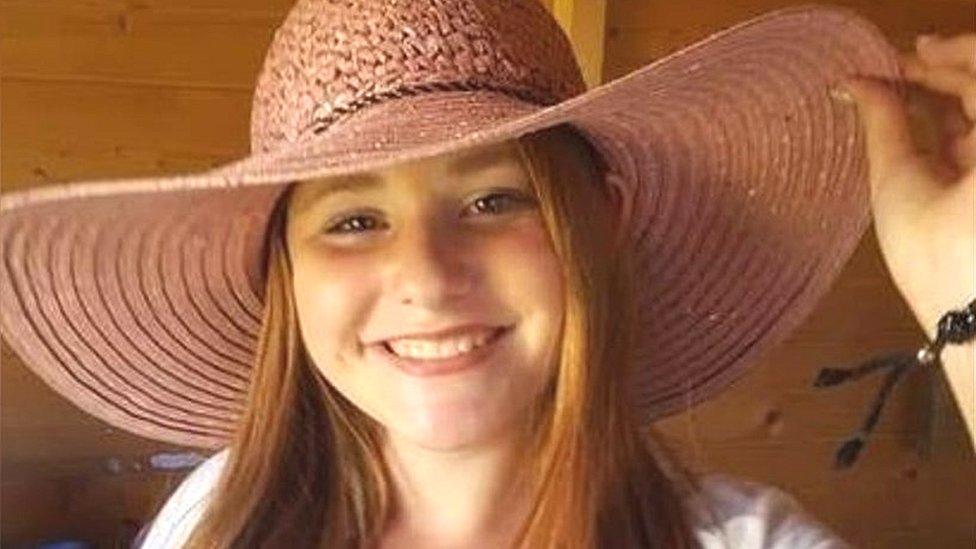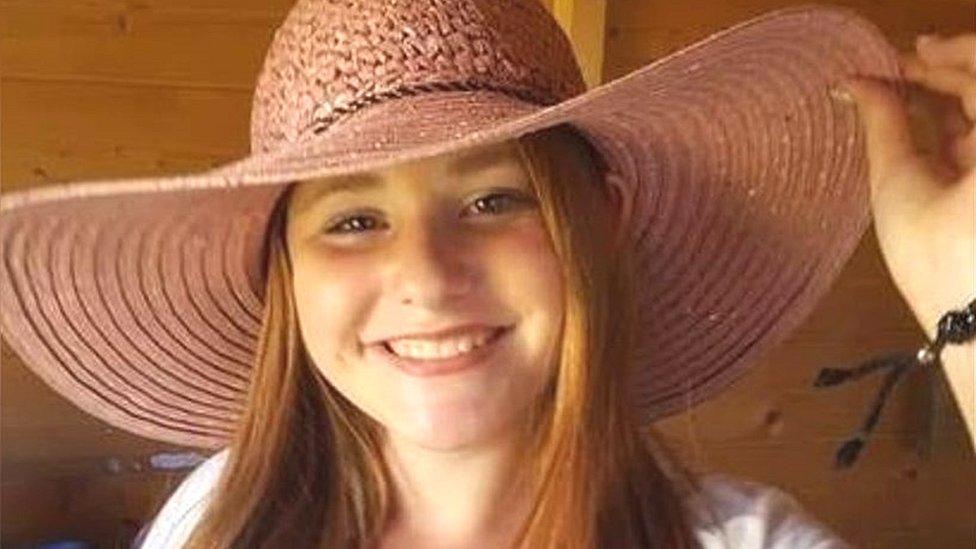Murder victim's DNA found in bin at brother's home
- Published

Amber Gibson's body was found in Cadzow Glen in Hamilton, days after she was last seen
DNA said to belong to a 16-year-old murder victim was found on clothing left in a bin outside the building where her brother was living, a court has heard.
Amber Gibson was found dead in Cadzow Glen in Hamilton in November 2021.
Connor Gibson, 20, is accused of sexually assaulting and murdering her. He denies the charges.
A jury was told a T-shirt and shorts described as belonging to Mr Gibson were recovered.
Blood matching Amber's DNA profile was found on the items, which were discovered in the bin outside the Blue Triangle housing project in Hamilton.
It was also found on trainers and a coat, said to belong to Mr Gibson, which were recovered from a room at the project.
Forensic biologist Alana Gunn was in the witness box for a second day to report on her findings after swabs were taken following the discovery of Amber's body.
She told the trial at the High Court in Glasgow: "In our opinion, the collective findings relating to Connor Gibson could be explained if he was involved in an assault on Amber Gibson and was also in contact with her while she was bleeding."
Blood matching Amber's profile was also found on a mobile phone case.
In her findings, she concluded that Mr Gibson had removed Amber's jogging bottoms and further had been in contact with the teenager's bra and top.
However, Ms Gunn was "unable to determine" whether this was as a result of causing damage to the latter items or handling them.
She added in the report: "As we were not provided any information regarding Connor Gibson's version of events, we are unable to evaluate further."
Prosecutor Richard Goddard asked the witness about the "assault" and blood staining which was analysed.
He asked Ms Gunn if the finding had been made due to its "distribution and appearance". The biologist agreed.

Amber Niven - also known as Amber Gibson - was 16 when she died in November 2021
Last week the court heard that Amber's brother's DNA was found on the garments she had worn.
Ms Gunn said, in her opinion, the forensic profile came from Mr Gibson's skin cells.
A jury was previously told that a forensic profile matching that of Stephen Corrigan, 45, was also found on the teenager's body.
He is accused of finding Amber's dead body, touching her inappropriately, hiding her body in bushes and branches and attempting to defeat the ends of justice.
He denies all the charges and has lodged a special defence of alibi.
Ms Gunn told the court that Mr Corrigan's DNA was found on 39 areas of Amber's dead body.
She concluded in her findings - based on his DNA on the body and from the clothes found at Cadzow Glen - that it was more likely that Mr Corrigan had been in direct contact with Amber when she was unclothed.
Ms Gunn also said said her findings were not consistent with Mr Corrigan's explanation that he had not had any contact with Amber.
When asked about why his DNA was found on the teenager's body, Mr Corrigan told police in an interview that sometime around July 2021 he had urinated in bushes in Cadzow Glen.
Ms Gunn said DNA may have been deposited from cellular matter which is sometimes found in urine.
But once urine had been deposited there had been "a lot of weather" and she would expect it would not be recoverable "four or five months later".
'Secondary transfer of DNA'
Mr Gibson's defence lawyer, Tony Graham, asked Ms Gunn if it was possible the DNA evidence linked to the accused on his sister's clothes could have been "secondary transfer" from being in close proximity while taking a photograph. Ms Gunn agreed it was possible.
Mr Graham also asked if it was true that DNA evidence from Mr Gibson had not been found on the victim's breasts, buttocks or intimate areas. She agreed it had not.
The court earlier heard that Ms Gibson had died from strangulation.
Mr Graham put it to Ms Gunn that, while there was evidence to suggest Amber was struck on the nose, "you could not provide evidence which suggested he (Mr Gibson) murdered Amber Gibson?
He said: "She didn't die of a blow to the nose. On that basis, would you accept that no part of the DNA jigsaw you bring to the court points to Connor Gibson?"
Ms Gunn said she could not comment on the claims but that there was no evidence to suggest "who came into contact with her neck" based on the findings.
The court heard Amber's body was found on 28 November 2021.
The trial, before Lord Mulholland, continues.
Related topics
- Published14 July 2023

- Published13 July 2023

- Published12 July 2023
